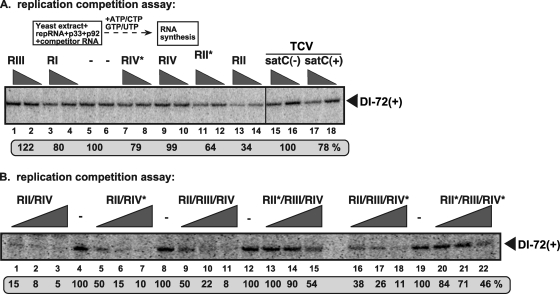Fig 4.
RII(+) RNA inhibits the in vitro assembly of the TBSV replicase. (A) Denaturing-PAGE analysis of the CFE-based replication assay. The in vitro replicase reconstitution assay contained yeast CFE, affinity-purified recombinant TBSV p33 and p92pol, and equal amounts of TBSV DI-72 plus-strand repRNA plus increasing amounts of competitor TBSV-derived RNA templates (RI, RII, RIII, and RIV [Fig. 1]) or the TCV-associated satC templates. The samples contained 0, 2, and 8 μg of competitor RNA, and each had 0.4 μg of DI-72(+) RNA template. The full-length DI-72-derived RNA products are depicted with arrowheads on the right. Note that the repRNA serves as both an assembly factor and a template in this assay, while the competitor RNA cannot assemble a functional replicase but can interfere with the replicase assembly process. The level of DI-72 repRNA replication in the no-competitor samples was set as 100%. (B) Another template competition in CFE-based replication assays. The competitor RNA contains the wt regions (RII, RIII, or RIV), a mutated RII (asterisk; C-to-G mutation in the C·C mismatch [Fig. 1A]), or a mutated RIV (asterisk; G-to-C mutation in gPR [Fig. 1A]). These mutations are known to interfere with the cis-acting replication functions of these regions. See further details in panel A. The samples contained 0, 3, and 9 μg of competitor RNA, and each had 0.4 μg of DI-72(+) RNA template.

